Join More Than 50,000+ Subscribers and get latest camera news and rumors
NEW CAMERA VIDEOS ON YOUTUBE
|
By admin, on February 14th, 2014
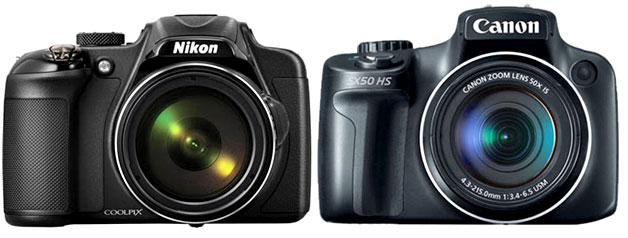
Nikon P600 features amazing 60x Optical Zoom NIKKOR Super ED VR Lens with 16 Megapixel CMOS sensor, on the other hand Canon has a limited 50X optical zoom and a 12 Megapixel CMOS sensor.
 Nikon P600 feature more resolution, more optical zoom and bright lens, the ISO range of Nikon P600 starts from 100 to 12800, so we not only get more zoom but we will also get improved image quality from Nikon P600 when compared to SX50 HS. Nikon P600 feature more resolution, more optical zoom and bright lens, the ISO range of Nikon P600 starts from 100 to 12800, so we not only get more zoom but we will also get improved image quality from Nikon P600 when compared to SX50 HS.
Nikon P600 features better shutter range compared to Canon SX50 HS and you also get bit fast shooting speed.
Nikon P600 offers Full HD video recording upto 60fps and on the other hand Canon SX50 HS Full HD video recording to limited to 30fps only.
Nikon P600 features better and bigger display unit compared to Nikon P600.
Nikon P600 also offers Built-in WiFi for remote shooting and wireless file sharing, No built-in or optional WiFi available in SX50 HS.
Verdict: Nikon P600 features more zoom, more megapixel and more ISO range for better low-light perforamnce, hence we recommend you to buy Nikon P600 over Canon SX50 HS
Buy Nikon P600 from Amazon | Buy Canon SX50 HS from Amazon
By admin, on February 2nd, 2014

The Fujifilm X-T1 is latest camera from fuji X-series mirrorless system and on the other hand the OMD E-M1 is flagship camera of digital OMD series, the basic and most common difference between these two camera is the size of the sensor, the Fujifilm X-T1 features a large APS-C size sensor and Olympus E-M1 have M4/3 Size sensor.
For more detailed specification take a look at the detailed specification comparison review below…
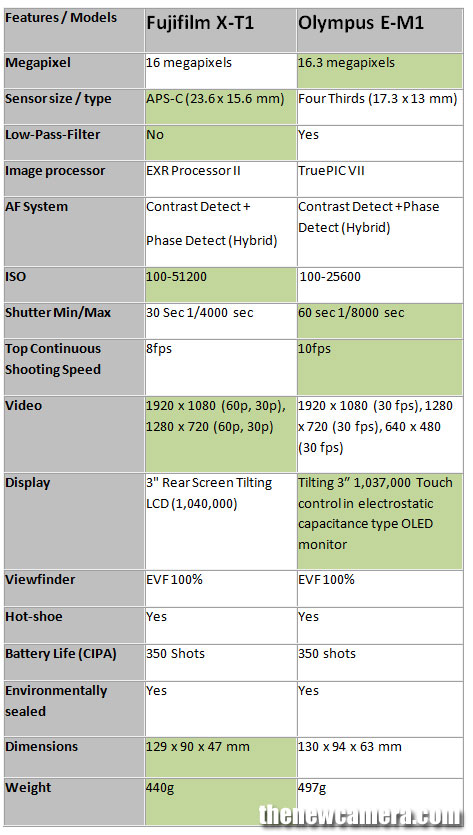
Sensor: Fujifilm X-T1 features a 16 megapixel X-Trans CMOS sensor, the X-Trans bespoke pixel array, the sensor is designed with a randomized pixel pattern that completely eliminate the need of an optical low-pass filter without moiré and aliasing problems.
Olumpus E-M1 Comes with a Four Third format sensor, the sensor is smaller and will not perform as X-T1 camera in-terms of noise and dynamic range.
ISO Range of X-T1 is one stop more than Olympus E-M1, so you will sure get less noise in X-T1 images.
AF system: Both autofocus system that employs both contrast- and phase-detection methods / Both sensor have built in phase AF points so you get fast Auto Focus speed during still and video shoot.
Shutter: The Olympus E-M1 have upper hand here since you get better shutter range and fast top continuous shooting speed compared to fujifilm X-T1.
Image Stabilization: The Olympus E-M1 have built in Image stabilization, it compensates for camera movements up to five shutter speed steps. The five axis work in vertical angle rotation, horizontal angle rotation, horizontal shift, vertical shift, and rolling camera shake movements.
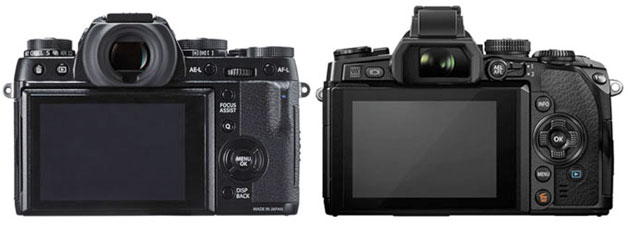
Display:: The X-T1 features 3.0″ 1,040k-Dot Tilting LCD Monitor and on the other hand Olympus E-M1 3.0″ 1,037k-Dot Tilting LCD Touchscreen, so Olympus wins here.
Both camera features rugged body and built-in WiFi Connectivity.
Verdict: The Fujifilm X-T1 will give you bigger sensor, more ISO range, no optical low pass filter for super sharp images and better video mode, on the other hand the E-M1 will give you bit fast shutter speed and built-in 5 axis image stabilization.
We recommend you to buy Fujifilm X-T1.
Buy Fujifilm X-T1 from Amazon || B&H
Buy Olympus E-M1 from Amazon || B&H
By admin, on January 27th, 2014
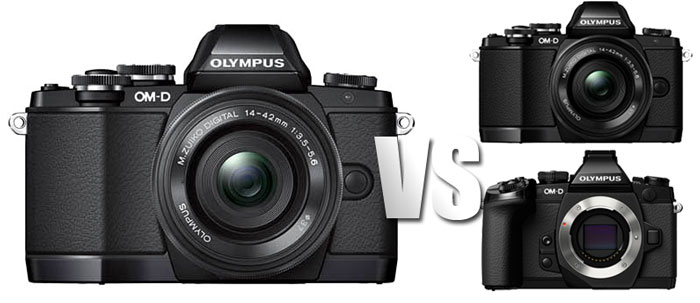
Take a look at quick specification comparison between these three cameras and as we all know the E-M10 is not announced yet so we may have some error in E-M10 specification, however we will also publish a detailed specification comparison review between these cameras and more after the announcement .
 We don’t see any major improvement in core specification of the upcoming E-M10 camera, Stay with us on Facebook and twitter to get more news and latest Olympus rumors. We don’t see any major improvement in core specification of the upcoming E-M10 camera, Stay with us on Facebook and twitter to get more news and latest Olympus rumors.
By admin, on January 26th, 2014

We have done a quick specification comparison review between these three camera, the to be announced X-T1 have bit more ISO range. fast continuous shooting speed, + Fuji X-T1 also gives you quick access manual control dials over the top and eye catching weather sealed retro design compared to its compatitiors.
The table may contain some errors as the final specification is not out yet, we will soon publish detailed specification comparison after the announcement of the Fuji X-T1
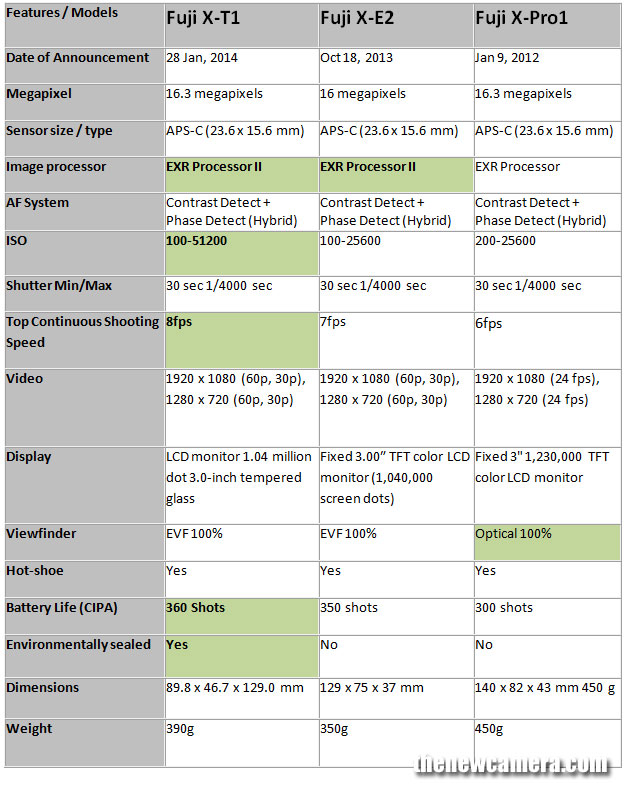
By admin, on January 25th, 2014

Nikon D3300 is a entry level camera from Nikon that comes without low-pass filter so you get sharp images and great details when viewed at 100% and Canon 100D comes with a 18.0MP APS-C CMOS Sensor, ISO upto 25600 and 3.0″ Clear View II Touchscreen LCD.
 Nikon D3300 gives you more megapixel and bit bigger sensor size compared to Canon 100D / SL1. Nikon D3300 gives you more megapixel and bit bigger sensor size compared to Canon 100D / SL1.
Nikon D3300 vs Canon 100D Sensor
The sensor of Canon 100D is bit advance since it features active Phase AF pixels fabricated within the sensor, the ISO range of Canon 100D is approx 25600.
Nikon D3300 have traditional CMOS sensor with additional benefit that it doesn’t have built-in low pass filter, so you get super sharp images.
Nikon D3300 will give you better image quality when compared to Canon 100D / SL1
Nikon D3300 vs Canon 100D AF system
Canon 100D / SL1 features 9-point AF system (including a high-precision dual-cross center point) +Hybrid CMOS AF System is utilized when shooting photos and video in Live View, so the phase AF system is active even shooting at live-view mode.
The Nikon D3300 have 11 point AF system, no cross AF points available and neither we have active phase AF pixels in the sensor , so contrast based AF system is active while shooting video or doing AF while using live-view mode.
Canon 100D / SL1 have advance AF system compared to Nikon D3300.
Videos
Nikon D3300 feature Full HD video recording at 60 fps, as well as HD 720p and SD 480p in multiple frame rates, in the MPEG-4 AVC/H.264 format.
Canon 100D / SL1 limited to 30fps in Full HD video mode and Movie Servo for continuous focus tracking of moving subjects during recording / phase AF pixels active while video recording.
The Nikon D3300 have better frame rates but uses contrast based AF system whereas Canon 100D have active Phase + Contrast AF system while while recording videos.
Canon also have STM range of lenses that supports silent AF motor that works silently / without adding AF noise in your video.
Display: Canon 100D have 3.0″ Clear View II Touchscreen LCD display and Nikon D3300 have 3.0″ 921k-Dot LCD Monitor.
Canon 100D have more better display compared to Nikon D3300.
Verdict: Nikon D3300 will give you bit better image quality and more frame rates while video recording and Canon 100D comes with Hybrid AF that works perfectly in still and video mode. If you prefer image quality go for Nikon D3300 and if you are looking for a complete package of features go for Canon 100D / SL1.
Buy Nikon D3300 from Amazon – B&H |
By admin, on January 19th, 2014
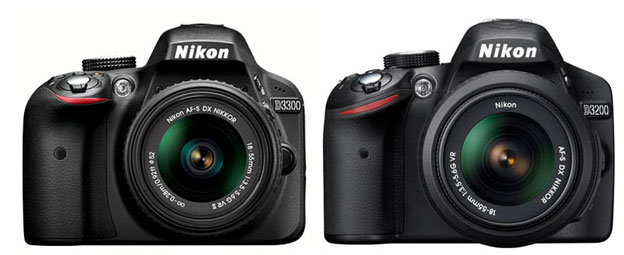 We are doing a comparison review With Nikon D3200 successor, Nikon D3300 have a new sensor (according to Nikon), advance image processor and no built-in low pass filter, take a look below for more details… We are doing a comparison review With Nikon D3200 successor, Nikon D3300 have a new sensor (according to Nikon), advance image processor and no built-in low pass filter, take a look below for more details…
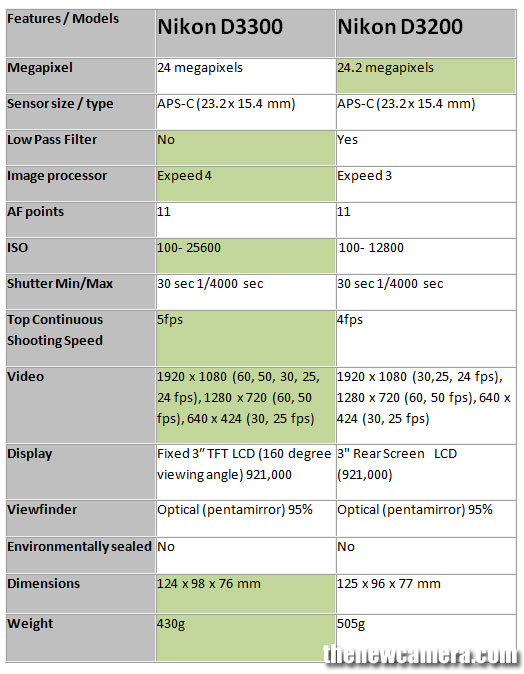 From Table we can clearly see that From Table we can clearly see that
Low-pass Filter: Nikon D3300 doesn’t have low pass filter so you get sharp images compared to Nikon D3200
optical low-pass filter is removed in Nikon D3300 to gain the utmost sharpness and resolution from both photos and videos
Improved image processor: New image processor helps to get more clear JPEG output, improved shutter range and better video mode.
More ISO range: The Nikon D3300 ISO range is upto 25600 and Nikon D3200 limited to 12800.
Video: You get Full HD video capture at 60fps and Full HD video capture.
Verdict: Based on specification comparison review we recommend you to buy Nikon D3300
Buy Nikon D3300 from Amazon – B&H || Buy Nikon D3200 from Amazon
By admin, on January 14th, 2014
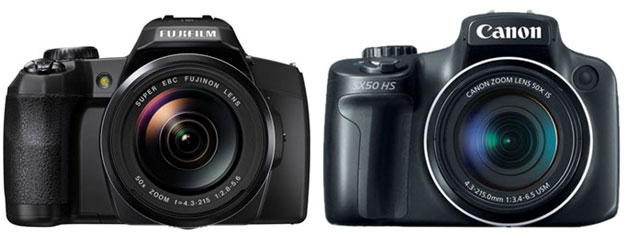 Fujifilm S1 vs Canon SX50 HS, the fujifilm features same optical zoom as Canon SX50 HS and some brand new feature, for more details take a look below Fujifilm S1 vs Canon SX50 HS, the fujifilm features same optical zoom as Canon SX50 HS and some brand new feature, for more details take a look below
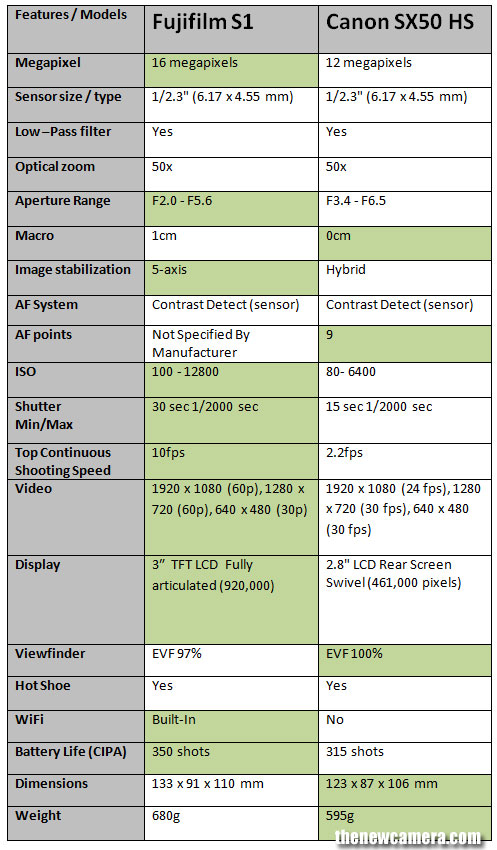 Sensor : Canon uses 12.1MP 1/2.3″ CMOS image sensor , the Fujifilm uses newly developed 16.4 megapixel 1/2.3″ CMOS sensor. Sensor : Canon uses 12.1MP 1/2.3″ CMOS image sensor , the Fujifilm uses newly developed 16.4 megapixel 1/2.3″ CMOS sensor.
ISO range : You get more ISO range with Fujifilm S1, + Fuji comes with bright aperture lens compared SX 50 HS, hence you will sure get less noise in HIGH ISO images compared to SX50 HS.
RAW– Both camera features RAW shooting mode, Canon SX50 HS captures RAW still images–including RAW+JPEG, the Fujifilm S1 can also record files in the RAW, or RAW+JPEG, formats
Image Stabilization: Both cameras features advance IS system, but Fuji S1 IS is better compared to Canon SX 50 HS.
- Fujifilm comes with 5 axis IS – The 2-axis optical image stabilization system counters both pitch and yaw movements and the rest 3-axis electronic image stabilization system compensates for roll, vertical shift, and horizontal shift movement types.
- Canon SX50 HS comes with Intelligent IS – It automatically select from six different modes to optimize image stabilization for the given situation: Normal, Panning, Macro (Hybrid) and Tripod IS for stills; and Dynamic, Powered, Macro and Tripod IS for video.
Shutter: Fujifilm features more shutter (Min/Max) range and fast continuous shooting speed upto 10 fps, Canon SX 50 HS limited to 2.2 fps only.
Video With S1 you can capture Full HD videos @ 60fps, Canon is limited to 60fps.
Display: Fujifilm is better with 3.0″ 920k-Dot Vari-Angle LCD Monitor and Canon 2.8″ display limited to 461K pixels and yes both are vari-angle.
Other features of S1 not available in Fujifilm S1
- Built-In Wi-Fi Connectivity
- Dust and Weather-Resistant Body Design
- Time Lapse shooting
Verdict: We highly recommend you to buy Fujifilm S1
.
Fujifilm S1 from Amazon | B&H
Canon SX50 HS from Amazon | B&H
|
KEEP THIS BLOG ALIVE - Support New Camera Buy Canon Lenses, Buy Music CD or Digital Camera at amazon it helps this site, and you do not pay anything extra, it is just a way to help support this site.

|

 Nikon P600 feature more resolution, more optical zoom and bright lens, the ISO range of Nikon P600 starts from 100 to 12800, so we not only get more zoom but we will also get improved image quality from Nikon P600 when compared to SX50 HS.
Nikon P600 feature more resolution, more optical zoom and bright lens, the ISO range of Nikon P600 starts from 100 to 12800, so we not only get more zoom but we will also get improved image quality from Nikon P600 when compared to SX50 HS.




 We don’t see any major improvement in core specification of the upcoming E-M10 camera, Stay with us on
We don’t see any major improvement in core specification of the upcoming E-M10 camera, Stay with us on 











